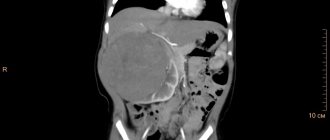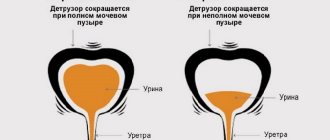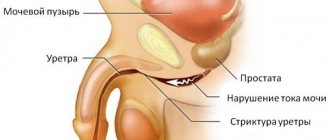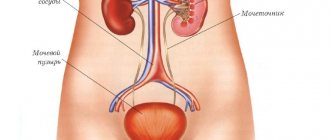Nephrotic syndrome in children is a set of interconnected clinical and laboratory signs of a pathological renal symptom complex, including:
- severe proteinuria (2.5 g/day or more);
- hypoproteinemia, especially hypoalbuminemia (<25 g/l);
- hyperlipidemia;
- pronounced swelling.
The incidence of nephrotic syndrome (NS) in children is 15 cases per 100,000 people. At an early age, the incidence among boys is twice as high as the incidence among girls, but in adolescence, the incidence of NS between both sexes levels out.
Sign of nephrotic syndrome in a boy
Causes of the syndrome
The cause of NS is massive proteinuria, which is caused by “podocyte foot disease” - processes of renal epithelial cells that impede the excretion of macromolecules, including protein molecules, during filtration in the glomeruli. With NS, the “feet” of the renal epithelial cells “disappear,” creating favorable conditions for protein molecules to enter the secondary urine.
There is also a hypothesis about the existence of a “circulating permeability factor” that can negatively affect the “work” of the glomerular filter.
Observation
After achieving remission of nephrotic syndrome, the child is registered at the dispensary, which is subject to registration until transfer to an adult clinic. Observation is indicated even in the absence of relapses. After discharge from the hospital, a general urine test is performed every 2 weeks for the first 3 months, then once a month during the first year of observation, and once every 3 months in subsequent years (provided there are no relapses). OAM is also performed against the background of any exacerbation of chronic (bronchitis, gastritis) or acute intercurrent diseases (ARVI, etc.) - at the onset of the disease and 10-14 days after recovery. All appointments with a nephrologist and pediatrician must include mandatory measurement of blood pressure for a child of any age.
Varieties
Based on the etiology, NS is classified into primary, which is divided into:
- congenital - in children under 3 months;
- infantile – in babies 3-12 months;
- idiopathic – in children older than 12 months (the cause of NS is unknown);
And secondary, developed against the background of hereditary, congenital or acquired diseases:
- systemic collagenosis;
- hereditary nephritis;
- diabetes mellitus;
- vasculitis of a systemic nature;
- amyloidosis,
- renal vein thrombosis;
- reactions to taking medications (drugs containing gold, bismuth or mercury);
- snake bites (efa);
- infectious diseases (tuberculosis, syphilis).
Based on the predominance of certain clinical forms, NS is divided into:
- pure (with signs typical of NS) and mixed (with the addition of signs uncharacteristic of NS);
- complete (with a characteristic set of pathognomonic symptoms) and incomplete (albuminuria without edema).
Differential diagnosis
MINS is differentiated from NS during GN, that is, from RPGN, primary chronic GN, congenital and familial NS, primary amyloidosis, secondary NS (poisoning, diffuse connective tissue diseases, etc.). Along with the analysis of the anamnesis and clinical picture, laboratory data, the results of a kidney biopsy are also taken into account.
Indications for kidney biopsy in patients with NS are: an ineffective 1-2 month course of prednisone therapy at full dose, the presence of persistent signs of “nephritic syndrome” (hypertension, azotemia, hematuria) in a patient with NS (hypertension, azotemia, hematuria), as well as low complement levels in the peripheral blood, pedigree data on several patients with nephropathies in the child’s family.
Development mechanism
Edema develops due to severe protein loss. Albumin creates oncotic pressure in the blood plasma, retaining water in the bloodstream. A decrease in the amount of blood proteins leads to the fact that water molecules are no longer retained in the vessels and begin to penetrate into the tissues. Hyperhydration of soft tissues leads to a compensatory increase in the outflow of lymphatic fluid, along with which tissue proteins are removed, which, in turn, leads to a decrease in the oncotic pressure of the interstitial fluid, which can be considered as one of the mechanisms to compensate for the development of edema during hyperproteinuria.
Main symptoms of the disease
The clinical picture of the pathology has certain features that make it possible to distinguish nephritic syndrome from all others. There are both general symptoms (associated with damage to the whole body) and local ones (affecting only the kidneys).
Manifestations of the first group include:
- dyspepsia (nausea, vomiting, heartburn without connection with meals);
- general intoxication (headaches in the temporal region, weakness, lethargy, drowsiness);
- an increase in blood pressure by 20–40 mmHg above normal;
- tendency to colds.
Typically for local symptoms:
- the presence of pain and swelling in the lumbar region;
- change in color and turbidity of urine (redness and appearance of foreign impurities);
- swelling of the face (especially eyelids, cheeks and neck);
- decrease in the volume of urine excreted (oliguria).
One of my patients had an atypical course of the disease. The man was completely free of all symptoms of intoxication and blood was detected in his urine only once
Since the patient suffered from arterial hypertension, other doctors did not pay attention to the increase in blood pressure. It was possible to identify the presence of nephritic syndrome only after additional examination of the kidneys
Clinical manifestations
“Classical” pure and complete NS is characterized by:
- the appearance of pronounced swelling (on the face, eyelids, lumbar region and legs), which may be accompanied by shortness of breath and palpitations;
- symptoms of intoxication (general weakness, nausea and vomiting);
- secondary hyperaldosteronism;
- oliguria;
- feeling of thirst and dry mouth.
Metabolic disorders lead to trophic disorders of the skin, which becomes dry, begins to peel and becomes covered with cracks.
Edema in children tends to rapidly increase; for this reason, very often when diagnosing NS it is necessary to carry out a differential diagnosis with Quincke's edema (angioedema of an allergic nature).
It is important to distinguish Quincke's edema from nephrotic syndrome!
Complications of the disease in children
Basically, the primary form of nephrotic syndrome occurs at an early age, which responds well to treatment. With timely detection of pathology and provision of assistance, doctors give favorable prognoses. If the disease is secondary, then recovery directly depends on the disease that became the root cause:
- Due to the massive loss of proteins in the body, blood volume may decrease (hypovolemia). Patients experience a decrease in immunity, therefore the risk of colds increases.
- Due to the accumulation of fluid in the chest cavity, pulmonary edema often occurs.
- Due to the lack of timely treatment, cerebral edema, stroke, and myocardial infarction may occur.
In the near future, such children develop chronic renal failure, which in most cases leads the patient to the operating table.
To avoid the occurrence of nephrotic syndrome and other kidney diseases, the following recommendations must be followed:
- dress children warmer in cold weather to avoid hypothermia;
- treat infectious and inflammatory diseases in a timely manner;
- strengthen the immune system.
It should be remembered that many kidney pathologies develop completely asymptomatic at first. Their presence can only be determined through special research. Therefore, parents should bring their children for a preventive examination to a therapist and nephrologist at least twice a year. This will help to detect pathology in time and avoid negative consequences.
Diagnostic measures
Laboratory tests reveal, firstly, changes in the blood:
- hypoproteinemia, hypoalbuminemia (less than 40 g/l) and dysproteinemia (change in the normal ratio of albumin and globulins with an increase in the level of the latter);
- moderate anemia, significant increase in ESR and increase in platelet count;
- hyperlipidemia.
Secondly, changes in urine:
- significant proteinuria with the amount of excreted protein above 2.5 g/day;
- microhematuria (red blood cells are determined by microscopy of urine) - with a mixed form of NS.
The mixed form of NS is also sometimes accompanied by an increase in blood pressure.
How to prevent
The only way to prevent it is to control diseases that can cause kidney infection or damage.
Prevention of early relapse in the case of idiopathic nephrotic syndrome can be accomplished by partial cortisol replacement. It prevents half of the relapses predicted within three months of remission.
Children suffering from nephrotic syndrome may need to make dietary changes and create a healthy lifestyle to boost immunity. Parents and educators should prepare healthy, balanced meals. Encourage children to exercise regularly, and get enough sleep.
Treatment
The form of NS in children is usually primary and is relatively easy to treat. Treatment of NS is always carried out in a hospital setting in the nephrology department. At the beginning, the child is on bed rest. In the future, the transition to ward and general is carried out. In order to prevent physical inactivity, muscle wasting, as well as a decrease in the rheological properties of blood, the child is prescribed exercise therapy and massage from the first days of hospital stay.
To stop the pathological process, glucocorticoids (Prednisolone) are usually prescribed at a dosage of 2 mg/kg/day. The course of treatment is 1.5-2 months. If the response to the drug is positive, its dose begins to be gradually reduced by 0.5 mg/kg/day every 4 weeks, followed by discontinuation. The duration of taking glucocorticoids is usually 6 months.
If hormone-sensitive NS is prone to relapse, the duration of steroid therapy is reduced to 3-4 months.
If the NS is resistant to treatment with Prednisolone, pulse therapy with Methylprednisolone is possible. If there is no effect from pulse therapy, NS is considered steroid-resistant. In this case, the issue of prescribing cytostatics and selective immunosuppressants (Cyclophosphamide, Cyclosporin A) is decided. If steroid resistance is detected, a kidney biopsy is performed.
Due to the increase in blood clotting properties, in order to prevent DIC syndrome (systemic thrombosis), Heparin or its low molecular weight analogue, Fraxiparine, can be prescribed.
To ensure maximum effectiveness from drug therapy, the child is prescribed a special diet that includes:
- maximum reduction in the amount of table salt taken per day;
- water restriction, its volume should be equal to the daily urine output along with an additional volume of water, calculated by the formula: 15 ml/kg of weight;
- limiting fat;
- exclusion of spices, smoked meats and broths.
No special measures have been developed to prevent NS. To avoid relapse, you should adhere to measures to prevent diseases of the urinary system (ARVI, hypothermia). If necessary, you should consult a pediatrician or nephrologist.
Regarding the advisability of using traditional medicine, there is no consensus among doctors. Most experts agree that they can only be used with the permission of the attending physician. Widespread:
- decoctions based on lingonberry and cranberry fruits;
- infusion of juniper, parsley and fennel;
- a decoction of birch leaves, buds and horsetail.
- Drinks made from lingonberries and cranberries are recommended to be used in the form of fruit drinks.
Diagnostic methods
If the first signs of this disease occur, you should consult a doctor. He will conduct a survey, examine the patient and give directions for the following laboratory tests:
- General urine analysis. As a rule, patients have a large amount of protein in their urine and an increase in its density.
- General blood analysis. The erythrocyte sedimentation rate and the number of leukocytes increase, which indicates the presence of an inflammatory process in the body.
- Blood test for total protein. In patients, the amount of protein is reduced (hypoproteinemia).
- Urine culture for sterility. It is carried out to determine the pathogen that caused the inflammation and its sensitivity to antibacterial drugs.
- Biopsy. A tissue sample is taken to determine why protein levels in the urine are elevated. It is used if a trial course of glucocorticosteroids (drugs that reduce protein synthesis and increase its breakdown) does not produce positive results.
Blood test for total protein
Based on these studies, the doctor makes a final diagnosis and prescribes the necessary treatment.











